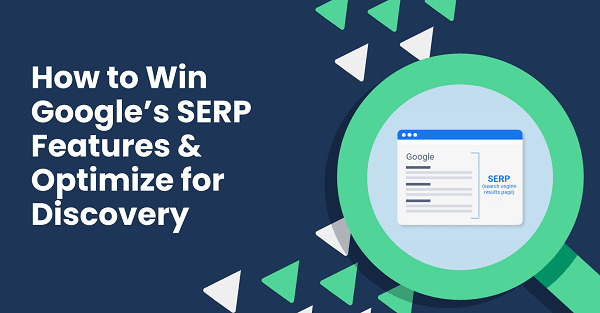Curious about how to unlock the true power of Google’s SERP features? Learn effective ways of tapping into the full potential of these priceless result types and ensure your brand is visible using the strategic approach explained in this article.
Common Google SERP Features
Whether Google is updating its search engine ranking algorithm or publishing new features, it has one key goal: to make the information organization for users better. And there’s no better way of doing that than giving answers that best answer what a user is asking overfold through SERP features.

Some commonly encountered SERP features include:
- Featured snippets: These are the bold answers that come atop of the result page directly in response to a user’s query.
- Knowledge panels: These are blocks of information that appear on the right side of search results and provide information about any one of a special category of entities, such as businesses, celebrities, or landmarks.
- Local packs: Relevant business listings, including their addresses and phone numbers, users’ reviews of those businesses. They appear right-sided on desktops, while on mobile, they always top the fold.
- Image packs and video carousels: A group of relevant images or video material to a query, appearing in a dominant way inside the results the user opens or watches them on the same page.
- Sitelinks: These are further links from the main result, directly to specific parts of a website.
- People also ask: Expandable question boxes comprising related questions and their answers in relations to the search query that may refer to other domains.
- Rich snippets: In essence, normal search results but with the added advantage of more information such as star ratings, price, availability that enables the user to have more background.
- Reviews: Ratings and reviews that appear in business listings, giving an idea about the quality of products or services.
Keep in mind that the above-mentioned SERP features may appear more for some users than for others because their availability depends on such factors as location, search query, and device. Additionally, other result types, such as job and event listings or flights and hotels, will appear only for relevant question types.
Enhancing SEO content to target featured snippets.
The featured snippets are some of the most common and wanted SERP features, usually made up of three elements: a title that is a short summary of the information; the content snippet, which should be short and direct to answer or solve the user’s query; and the URL source, showing the website from which this information was taken.
When developing your content to earn featured snippets, you need to make sure it’s well-structured and compact information that answers typical user queries.
For instance, if your site is about cooking recipes, you might have set up a blueprint for providing a series of steps or itemized lists that answer particular questions about cooking recipes.
You may also like An Overview of the Evolution of Search Engine Optimization
Optimizing important on-page elements can go a long way in helping you appear in snippets. First, optimize your headings and subheadings to clearly denote sections where the answers to certain questions can be located. Use question-based headlines (“Can You Cook Salmon in an Air Fryer?”) and provide direct answers in opening sentences.
Generative AI tools like ChatGPT or Google Bard can assist in writing fully optimized content.
Also, you can further provide more context to the search engines and better stand a chance of having your content featured as a snippet by using structured data markup through schema.org.
Other ways to better your chances of being featured within the snippets include:
- Identify commonly queried questions within your industry or sector and create content pieces that perform well for those queries.
- Take more notice of long-tail keywords and questions, as these will more often yield featured snippets.
- As mobile has taken over the popular type of searching, make sure your content is optimized for mobile.
- Visuals like images, charts, or infographics are some formats that increase the visual attractiveness and interactivity of your content.
Enhancing Local SEO with Google’s local packs
Think of the last time you’ve ever used “near me” in a Google search. As the owner of a restaurant, retail store, or professional service, optimizing your online visibility to show up with local searches is one of the surest methods to pop into the attention of potential customers who are searching nearby.
However, many businesses still look down on the use of local SEO in their general strategy, despite the fact that almost 98% of people use Google to find information about local businesses. This, therefore, highlights the importance of mastering the features of Google’s Local Pack.
At a minimum, you should completely fill out your Google Business profile so that it shows up in the local packs. You put accurate, up-to-date details about your address, phone number, hours, and website link.
Local SEO will optimize your website for local results but also provide many more advantages. It begins with thorough keyword research that also involves location-based keywords. Taking the above coffee shop example, you need to focus on longer phrases too, like “the best coffee shops in Chicago” or even “coffee near me.”
This is going to be accomplished through the smooth inclusion of these keywords in the meta tags, headings, content, and URLs, which in turn increases the presence likelihood of your business near the top of the page for users with turned-on location targeting.
You may also like How to Improve the ROI of Your SEO Strategy
Create location-based landing pages or blog posts that include your business in the context of the local area with its attractions or events. This is especially important for chains or brands with different locations across various cities, desiring to target each geographic region.
Harnessing The Potential of Knowledge Panels and Rich Results
The knowledge panel and rich results are strong SERP features that directly display essential information about a person, brand, or topic on the search engine results page. They are quick glimpses into the main points of view; like entity descriptions, website links, social media profiles, and notable achievements.
The advantages of appearing in such results are manifold, with the added advantage of enhancing your brand’s credibility through expertise, authority, and user trust. So, to get your website content optimized for knowledge panels and rich results, make sure you provide full and accurate information about the entity or topic at hand.
Since December 2022, the elements of E-A-T have included another “E”, namely experience. In other words, when content is written from first-hand experience it stands a better chance of ranking high. Target those topics that you or your team feel confident about writing about from experience.
As with featured snippets, the more concise, compelling, and highlighting of your unique selling points or core expertise an entity description is, the better it will appear.
Structured data markup also plays a significant role in making your website content eligible to show knowledge panel and rich results. You give additional context with this code so search engines can understand and present your information in a more meaningful and visually appealing way.
Active inclusion in knowledge panels is earned and maintained with the help and support of your audience and customer base. Here are a few considerations:
- Encourage reputable sources to mention and link to your entity to help build out your web presence and enhance the likelihood of knowledge panel inclusion.
- Foster a strong online reputation by being proactive in managing and responding to customer reviews and feedback.
- Keep updating and enriching your entity’s information to feed the search engine with the most relevant and comprehensive pieces of information.
- Be sure to regularly check that knowledge panel for correctness; correct and update whenever necessary.
You may also like SEO Metrics: What are they and why do they matter?
Utilizing visual SERP features
For certain content types, limitations can be held with the capability to fully convey their message with traditional articles alone. Google has taken notice, and when a query is better benefited from an image or video pack, those are being prioritized more and more.
Creating elements such as images, videos, and carousels into your content significantly enhances the visibility of click-through rates and creates an increasingly useful experience for visitors to your website.
Attractive, high-quality images and videos related to the content attract users towards your website; and this can make users want to spend more time on the site. Thus, user engagement is assured.
Optimizing your multimedia content to reach Google’s visual SERP features should focus on the following:
Images
Improve discoverability of your images and speed up loading without sacrificing quality by following these key best practices from Google:
- Use descriptive file names: Use image file names that describe what is in them so search engines can crawl them more accurately.
- Use ALT tags: While inserting your images, make sure you fill in the alt text describing what is on the image. This is an alternative description in case your image does not load or is unavailable to be read. Alt tags are very important in terms of accessibility and assistive devices, meaning every user will know what is on your page.
- Caption them: Captions for images are a must since they provide context to the images and make reading your work much interesting.
- Compress images: You’d want to make the file size of your images smaller without sacrificing quality to make them load faster for a smoother experience.
Also, ensure that your visual content is relevant to the topic of your page. Try to avoid putting substantial text into your images. Sometimes, putting headings or menu items into pictures can make it inaccessible for people using assistive reading devices.
You may also like How is the Use of Knowledge Management Software Important?
By following these practices, you’re getting a little more out of the deal than just usability for your website, but also appealing to the Americans with Disabilities Act, ADA Standards for Accessible Design, which requires image alt text and captions to create equal access.
Videos
The following are some very important optimization techniques that will help to amplify the visibility and viewer engagement of your video content:
- Optimize Video Title, Description, and Tags: The search terms are used in this to rightly describe your content and make it more comprehensible by the crawlers so they can rank it accordingly.
- Create video thumbnails that capture interest: Create an attention-gaining thumbnail that is visually attractive to your audiences when your video shows up in search results.
- Publish on reputable platforms: Use established portals like YouTube or Vimeo to reach out to a greater audience and add that visibility your video needs.
- Structured Data Markup: This involves schema markup you should use—including VideoObject schema—to tell the search engines all about your video. The more the search engine knows about your content, the higher the chances of it featuring in rich snippets or even video carousels.
Integrate these tips to ensure that your video content is optimized to rank well in search results and find a larger viewership.
Embracing Google Bard, AI, and Preparing for The Future of SERP Features
What might Google Search look and feel like in the near future? According to Alphabet CEO Sundar Pichai, it’s going to be changed drastically over the next decade. And if recent launches in the form of Google Bard and rapid innovation happening in large language models (LLM) and generative AI go by, he isn’t entirely wrong.
Google Bard is the competitive conversational AI product of the company, putting ChatGPT out there and presenting a new interactive way for users. Though different from regular search, Bard can show search results, knowledge panels, and maps, and can even deliver local information. It is very likely that this chatbot experience will fuse with Google Search over time.
In return, SEO professionals are supposed to follow its effect on organic traffic and probably the ROI for brands advertising on Google Ads. This could change ad-based revenue models since chatbots or AI will try to summarize information without necessarily visiting the publisher’s websites. It also can impact subscription revenue models.
Google says it is committed to constantly working on ensuring a better user experience while at the same time continuing to support publishers reliant on advertising revenue. However, the long-term implications of AI remain uncertain.
Perspectives, from Google, provide further dimensions of the creators’ experiences, and another new markup for AI-generated images on websites.
One big change is the Search Generative Experience, which was released in May 2023. SGE answers powered by AI sit on top of the first traditional organic result and include the ability for users to expand and interact with the AI responses. Like other new features, SEOs should keep watching performance to understand its impact on CTRs and site traffic.
While the SGE will keep users on the results page, it’s also a chance for site visits similar to featured snippets. However, publishers and brands should be aware of these features that keep users in Google’s ecosystem while weighing the pros of reaching new audiences.
In this respect, for eCommerce businesses, SGE by Google can help consolidate millions of product listings into one place sourced from the Google Shopping Graph and thus act as a strong channel to reach out to new consumer segments.
As technology is fast changing, leveraging the potential of connecting to emerging AI-driven experiences becomes quite essential on the part of businesses to keep them ahead in today’s digital journey.
You may also like On-Page SEO Tips for Small and Medium Businesses
Present-day and future Google SERP features
The ever-changing landscape of search demands our stride in pace with the growing importance of SERP features to user experience. Our practices should be such that we can leverage these different features for maximum visibility and competitive advantage to reach our targeted audience.
Considering all this, creating a thoughtful approach to optimization for the SERP features existing today will definitely help increase our organic presence and be better positioned for whatever future advancements are made in AI and conversational technology. It goes without saying that this ever-evolving search environment calls for diligently monitoring organic traffic and ROI that AI-powered answers are contributing to.
The future of AI and conversational technology is the way forward for businesses that want to stay ahead, be competitive, and conquer the game in a digital world. This sets up more growth and prosperity in the ever-changing world of SEO.
Would you like to read more about how to get on the First Page of Google SERP-related articles? If so, we invite you to take a look at our other tech topics before you leave!
Use our Internet marketing service to help you rank on the first page of SERP.










